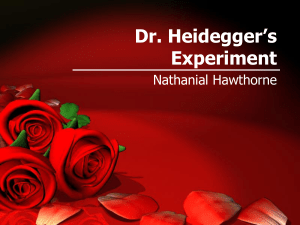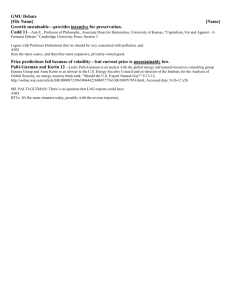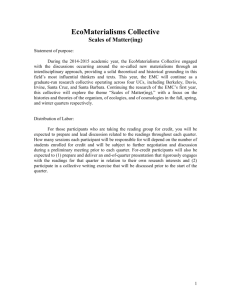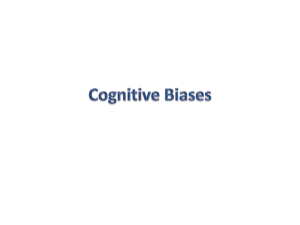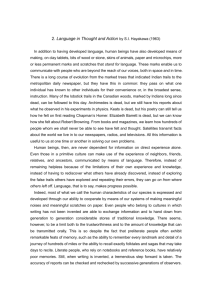THE SENTIENT-The ontology of Heidegger and Merleau
advertisement
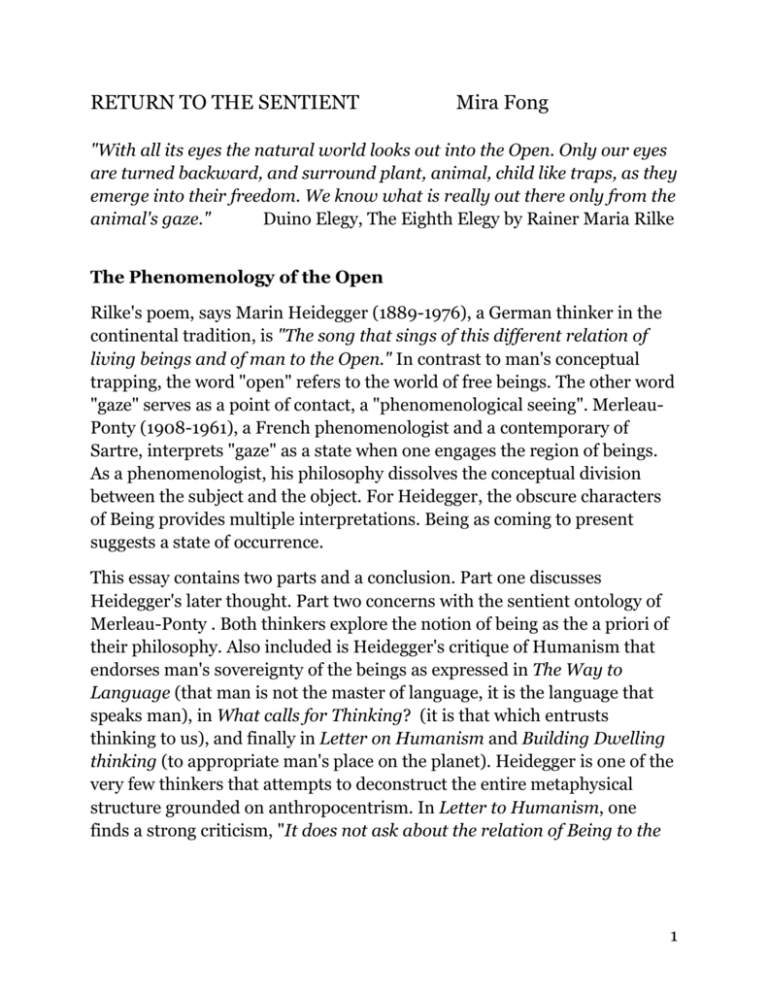
RETURN TO THE SENTIENT Mira Fong "With all its eyes the natural world looks out into the Open. Only our eyes are turned backward, and surround plant, animal, child like traps, as they emerge into their freedom. We know what is really out there only from the animal's gaze." Duino Elegy, The Eighth Elegy by Rainer Maria Rilke The Phenomenology of the Open Rilke's poem, says Marin Heidegger (1889-1976), a German thinker in the continental tradition, is "The song that sings of this different relation of living beings and of man to the Open." In contrast to man's conceptual trapping, the word "open" refers to the world of free beings. The other word "gaze" serves as a point of contact, a "phenomenological seeing". MerleauPonty (1908-1961), a French phenomenologist and a contemporary of Sartre, interprets "gaze" as a state when one engages the region of beings. As a phenomenologist, his philosophy dissolves the conceptual division between the subject and the object. For Heidegger, the obscure characters of Being provides multiple interpretations. Being as coming to present suggests a state of occurrence. This essay contains two parts and a conclusion. Part one discusses Heidegger's later thought. Part two concerns with the sentient ontology of Merleau-Ponty . Both thinkers explore the notion of being as the a priori of their philosophy. Also included is Heidegger's critique of Humanism that endorses man's sovereignty of the beings as expressed in The Way to Language (that man is not the master of language, it is the language that speaks man), in What calls for Thinking? (it is that which entrusts thinking to us), and finally in Letter on Humanism and Building Dwelling thinking (to appropriate man's place on the planet). Heidegger is one of the very few thinkers that attempts to deconstruct the entire metaphysical structure grounded on anthropocentrism. In Letter to Humanism, one finds a strong criticism, "It does not ask about the relation of Being to the 1 essence of man, because of its metaphysical origin, humanism, impedes the question by neither recognizing nor understanding it." Both Heidegger and Merleau-Ponty endeavor to invite beings into the open and propose a way of knowing in oppose to the conventional theory of correspondence (between the representation and the external entities), inference and calculative reasoning. For instance, the idea of perception, as they argue, is more complex than simply rendering as a merely epistemological function. The work of both thinkers in regarding to man's relation with beings suggests an ethical dimension. For instance, Heidegger advices that man must let go of his control and set beings free into their own essence. Phenomenology, modified by both Heidegger and Merleau-Ponty, was first developed by Edmund Husserl, a mathematician influenced by Gottlob Frege in the late 19th century. He later became critical of Frege's scientism which holds that only the modals of logic and mathematics are qualified as formal truths. Husserl thought that such method has limitation as it predetermines the outcome. He proposed that the grounding of truth is located in the intentional act of consciousness (noesis). Unlike the scientific method which treats the phenomenal world as object of investigation, Husserl's phenomenology, influenced by both Descartes (the primacy of first person experience) and Kant (based on an a priori foundation), seeks a new foundation of knowledge based on intersubjectivity. Husserl proclaims that phenomenology is to return to the things themselves, thus legitimizes the entire range of human experience, be it real or imagined. One simply describes that which appears in consciousness (noema) without any assertion. His idea, the life world (lebenswelt), refers to the sum total of one's experience including the activities of philosophy, psychology, arts and science. The problem of Husserl's phenomenology is that it deals with the phenomenal reality on a mental plane that could become a kind of solipsism by focusing on the noematic content of consciousness. He himself remained a rationalist and was mainly concerned with the foundation of 2 necessary truth (eidetic intuition). Having studied Husserl's work, both Heidegger and Merleau-ponty decided to move away from his transcendental orientation and applied phenomenology as a way of perceiving "what is given in one's experience". One intuits and corresponds with Being in a manner of relatedness. Phenomenology for the two thinkers implies a Gestalt approach to that which is occurring with an original openness to Being. "Phainomenon" in Greeks links to the word "light", meaning "that which shows itself from itself"; this view provides Heidegger with a new pathway of thinking and is the bedrock of his phenomenology. Part I Heidegger 1. Ontology by Way of Deconstruction The Greek word "onto" means "being or that which is". It is the study of being, the logos, or the reality. For the Greek sages, the notion of being implies forming a rapport with "that which is" and was considered as the way of truth. Heidegger's task was to hark back to the practice of the classical Greeks as philosophy at that time was the enquiry of the mystery of Being. In contrast, modern philosophy seeks scientific validation according to technical-theoretical exactness of concepts. Beings as merely entities are subjected to investigation. The word deconstruction correlates to the German word "destruktion". The term was used by Heidegger in his critique of Western metaphysics. He claims that philosophy since Plato has been a history of forgetting being and the question of being has since lapsed into oblivion. From Aristotle, Kant to the contemporary analytic philosophy, the Being of beings (things that have existence) has been subjected to a deductive treatment. Thinking is a matter of judgment according to a set of pre-determined concepts such as Descartes' innate ideas. Aristotle did extensive research on animal lives and developed the theory of "The great chain of Being" in his metaphysics. It is a hierarchical arrangement of beings according to their ability to reason, of which humans are on the top. Heidegger, who has had taught classes on Aristotle, disagreed, "Plato had a directive to think of Beings as idea, Kant had the directive to think of beings as the transcendental 3 character of objectness as position (being posited)." Being is neither a substance nor a transcendent reality such as Plato's Form or Hegel's Absolute Spirit. To ask the question "what is Being?" one must enter a pretheoretical and pre-representational mode of thinking. It's like a hidden path that leads to a clearing of the un-thought region of philosophy. Historically, metaphysics put man in the power center and kept beings in distance. Heidegger's mission is to deconstruct the entire philosophical tradition. In response to the question "what Being is?" Heidegger answers, "An investigation into Being really ought to be able to inquire about the Being of any being-an elephant in the jungles of India or the chemical process of combustion on Mars-any being at all." All entities are beings such as trees, mountains, rivers, animals, people, a poem or a sonnet. Being, in this sense, refers to the ground of beings, "The ground of beings has since ancient times been called Being, das Ereignis." Being as ereignis means "lit up" when being reveals itself into the open. 2. From Dasein to That Which Is The nature of consciousness if always about one's relation with the world. Early on, Heidegger's focus was to overcome the subject/object dichotomy in his investigation of man's existential conditions. The analysis of Dasein (human being) is the central theme of his major work, Being and Time (1927). By the thirties, his inquiry had moved on from Dasein to Mitsein (being with). The notion of Being (Sein), Heidegger argues, is not just an abstract concept or a representation (a mental picture). The means in which he uses in ontology is hermeneutics. It was a method primarily used by Wilhelm Dilthey, a German historian and hermeneutic philosopher. Dilthey's method "the hermeneutic circle" refers to a way of interpreting the whole text and its individual parts through a circular process of cross references. Inspired by Dilthey, Heidegger formulates a new paradigm of articulation through which the elusive character of being becomes accessible. In addition, Heidegger goes into etymology as way to retrieve the original meaning of Being. For example, "being" is associated with the 4 Greek word "origin" (der ursprung) meaning the first emergence of being from the hidden. As a logos, the Being of beings gathers into one including the opposites, similar to Hegel's version of cosmology. Being is ineffable, like the Tao. In 1946, Heidegger worked with a Chinese scholar in the translation of Tao Te Ching. He found the meaning of Tao, as described in chapter twenty-five of Tao Te Ching, bears the same connotation of Being, "Tao is quiet and elusive. It is invisible, the prior force of regeneration, ever moving in the cycles of growth. As mother nature, Tao is encompassing. It nourishes all living beings. Ever flowing, day and night, the Tao pervades all existence and returns to itself." Tao, as the Being of beings, gathers all beings in the hidden and releases them into venturing. The moon path that circles around the earth; wild animals wander in forests and fruits fermenting in the autumn sun, an overflowing river from the melting snow... 3. Unconcealment, the Encountering of Truth Philosophers of the early centuries were polymaths. They were preoccupied with the science of Copernicus, Kepler, Galileo and Descartes. During the age of Enlightenment, Kant organized knowledge into a framework of categories. In the beginning of 20th century, Bertrand Russell attempted to formulate an ideal language as a way of establishing reliable truth. Heidegger rejects such criterion. Truth is not to be found in the rigid structure of logical statements, nor by fixing beings in a controlled study for accuracy. Rather, the character of truth is its indeterminacy, a view was later elaborated by several postmodern thinkers. Heidegger asks, "How does truth happen?" His answer is, "truth is about the way of truth...It is what was brought into unconcealedness and held therein." The Greek word for truth is "Aletheia" or unconcealment. Truth is an activity, a happening in a pre-reflective state when Being emerges as self-revealing. "Unconcealment" has its archaeological origin from the mystical ritual of the ancient Greeks. The way one receives truth was by entering into the underworld where truth was revealed by the spirit. The experience of the presencing of truth described by the Greeks as a state of ecstasy (ek-stasis). 5 It literally means, "when one is besides oneself" or "to make room for truth to happen". Such a state was recorded in the poetic writings of Xenophanes, Parmenides, Empedocles and Heraclitus. For instance, Parmenides, an early Greek philosopher, differentiates between "the way of Truth" and "The Way of Seeming". Their views had asserted great influence on Heidegger. In the 1940s and early 1950s, he gave several lectures on Parmenides and Heraclitus, they echoed an esoteric view of the sages that "truth happens in the temple's standing where it is". 4. When Speaking Becomes Listening Linguistic philosophy investigates speech activities as propositions and statements. During the 1920s and 1930s, logical positivism aimed to make logic, mathematics and physics as the ideal model of knowledge. Richard Kearney, author of Modern Movements in European Philosophy, gives his reasons as to why he objects such treatment of languages, "Language has become a matter of propositional logic concerned with the representation and classification of the world. " This is the reason as to why Heidegger opposes linguistic philosophy. His view of language takes a different turn. Instead, he asks, "In what way does language occur as language?". Besides the usual application of language, he thought that language is a vehicle to access Being and to inaugurate things and world into man's consciousness. Parmenides had thought that listening to the words of truth is the same as thinking and being. For Heidegger, speaking and listening both take place in stillness, "It is language that needs and uses the speaking in order to sound as the peal of stillness for our listening." One experiences Aletheia when the speaking becomes the listening. In the peal of silence, one's senses open to faraway things; a fawn quietly steps into a deep woods; a falling leaf carried by the autumn wind or a flower opens its petals in early spring... Heidegger favors poetry over semantic interpretation. He gives these reasons, "Poetry is a form of primordial hermeneutic text that reveals the word as an opening, it offers to us the experience of being." Unlike the common usage of language that aims to represent things from its 6 externality, poetry opens to the life world from its roots, it is the essence of language. The early Romantics were fascinated by the mythical landscape of Greece. They believed that poetry has the power to transform man's soul or even the whole society. Similar to Hegel's vision of the "World Spirit" (Weltgeist), the notion of Being veiled behind Heidegger's mythical language, is the spirit of the early Romantics. His appreciation of poetry was influenced by the German romantic poets such as Goethe, Schiller, Novalis and Holderlin. In the backdrop of the Industrial Revolution in the 19th c, poets sought to revive man's spiritual connection with Nature. They defied scientific rules that restrict beings within the Newtonian physics. Poets are the troubadours wandering in the realm of beings. They sing myriad songs of the earth and the beasts. Albert Hofstadter, who translated Heidegger's Poetry, Language , Thought, gives his remark, "Translating Heidegger is essentially akin to translating poetry, for it is the poetry of truth and being that he has been composing all his life." 5. What is Called Thinking? Heidegger asks: "What does it mean by thinking? What is the task of thinking?" These questions convey a skeptic view regarding the theory of knowledge and the intellectual tradition of the West. From 1951 to 1952, Heidegger gave a lecture course on "What is Called Thinking?" (Was Heisst Denken) which was also a critique of the scientific method based on instrumental or calculative rationality. In order to free the mind from theoretical inhibition, Heidegger re-appropriates thinking from an aggressive to a receptive mode. He writes, "The question 'What calls for thinking?' asks for what wants to be thought about in an preeminent sense; it does not just give us something to think about, nor only itself, but it first gives thought and thinking to us." The question, "What calls us to think?" has to do with the activity of thinking as letting (seinlassen), "to let itself be claimed by being". It suggests a manner that we need to cultivate amidst the current environmental crisis. Thinking as intimation with beings is the only way to 7 save the Earth. The hierarchical thinking has everything to do with the demise of beings. Thinking in manner of objectifying beings is responsible for the industrial practice of "enframing". Since this lecture was delivered right after the war, it could suggest an attempt of the thinker to get to the root of man's destructiveness. Heidegger argues that there is a causal connection between the deductive and calculative thinking and man's assault on beings. For Heidegger, Parmenides and Heraclitus, are the two preeminent thinkers of Being. They belong together in thinking the true by embodying of mythos. Thinking for the sages is to summon the presentness of what is present. Thinking, described by Heidegger, is also an adventure, to think what was un-thought. It's like coming to a clearing in the woods. It opens the entire realm of beings where one experiences a state of "harmonia", of belonging together. The German word "an-denken" means "to think on" as well as "to remember". The act of thinking also has to do with thanking. According to Richard Kearney, "The thinking which Heidegger counsels is a nonobjectifying, non-systematic, non-calculative receptivity which enters the play of Being by giving thanks..." To answer to the question "what is called thinking?" is to cultivate a sensibility and an appreciation of the living world. For Dasein who lives in angst, thinking as thanking is a self transformation. 6. Dwelling within the Fourfold Constellation Heidegger's 1951 lecture, Building dwelling Thinking, was a cultural critique of the modern technological man. Dwelling (bauen) suggests a proper way in which humans are on the earth. The etymology of dwelling according to David Farrell Krell, "Dwelling or Wohnen in German means to reside or to stay, to dwell at peace, to be content; it is related to words that mean to grow accustomed to, or feel at home in a place. It is also tied to the German word for "delight." His translation enables the readers to understand Heidegger's notion of dwelling. It is connected to a primal constellation, the "Fourfold" (Das Geviert), that is, earth, sky, divinity and mortals. Each element is inseparable from the whole. Heidegger's Fourfold 8 theory is intended to deconstruct a human-centric world view. The four elements are inseparable, "on the earth' already means 'under the sky'...earth is the serving bearer, blossoming and fruiting, spreading out in rock and water, rising up into plant and animals." To extend his view further, the fourfold metaphor is quite significant when referring to the ecological connectedness. One of the four elements, divinity, serves as an ontological anchoring of a mythical origin. Nevertheless, Heidegger's concern for preserving Nature is obvious when he points out the root meaning of dwelling (man's way on the Earth) is to cherish, to protect and to preserve. Dwelling, as the sheltering Earth, holds the key premise of environmental ethics. However, dwelling has no specific locality since it also functions as a verb meaning "becoming home or to make man to dwell humbly on Earth". The inner working of the Earth within the Fourfold is essentially identical to the way of the Tao (the path) as illustrated in Heidegger, Ethics, and Animals (1992) by Professor Bruce V. Foltz. He explains, "Earth for Heidegger is not just, or even primarily a planet in cosmic space..Earth is for each entity that element from which it emerges into appearance, and into which it continually withdraws. ..the earth is what bears and gives rise to what comes to light only by remaining intrinsically dark itself. Earth is that which shelters and supports." 7. The World's Night, the Enframing of Beings The ambiguous notion of Being seems to be more accessible when Heidegger addresses the threat of modern technology. In the context of environmental ethics, Being implies the concrete existence of the Earth, humans and fellow beings. In December 1949, Heidegger gave four lecture courses to examine the essence of technology. His analysis discloses the paradoxical potential of Being (seems referring to human being here) as both unconcealment and a danger of enframing. One of these lectures, The Enframing, was published under the title, The Question Concerning Technology. It is an analysis of the essence of technology which has nothing 9 to do with modern technology. Beneath Heidegger's investigation is a warning to the Homo Sapiens and an effort to reclaim justice for the Earth beings. The word "technology" derives from the Greek word "techne", meaning the manner of making something appear such as in the creative process of art. According to Heidegger, Techne as a "bring-in-forth" has its origin in the essence of being. It means to bring something into illumination. However, as a creative force, techne also implies an inherent danger. It can manifest itself as a "setting upon" (stell). Heidegger explains, "The coming to presence of technology, Enframing, as the danger within Being, is Being itself". As such, techne could cover over the truth of Being and block its original opening. Implicitly, the notion, enframing, reveals a deep seated instinct in our species, that is, the will to power which is the engine of modern technology. The central premise of this lecture course mainly concerns with the way humans engage with the world through machination (machenshaft). As such, it threatens the Earth as sentient beings are regarded as useful materials. In his investigation, Heidegger argues that there is a causal connection between science such as physics and the metaphysical system. "Science" in Greek means "enquiry", a passion for discovery. Today's science and technology are instruments to empower man's domination over beings. It is in fact, Heidegger contends, the completion of Western philosophy, "In the age of Greek philosophy, a decisive characteristic of philosophy appears: the development of sciences within the field that philosophy opened up. The development of the sciences is at the same time their separation from philosophy and the establishment of their independence. This process belongs to the completion of philosophy." As the mode of "challenging-forth", enframing represents the threat of Technology. The natural world, the harboring place of all beings, is subjugated by the will of man. Heidegger laments, "The whole earth as a world market, but also, as will to will, trades in the nature of Being and thus subjects all beings to the trade of a calculation that dominates most 10 tenaciously...". Further, "Not only are living things technically objectivated in stock-breeding and exploitation... At the bottom, the essence of life is supposed to yield itself to technical production." The mode of enframing as such converts living entities into a "standing reserve" (bestand). Beings are ordered to stand by for a further ordering such as the "motorized" operation of extracting resources and the animal agriculture where animals are kept in concentration camps as stocks and inventories. The technological man is trapped in the instrumental aspect of techne and a destructive cycle of production and consumption. Amidst the environmental crisis, it's up to all of us to choose, either to be in the company of impersonal machines or a warm relation with fellow beings. In his essay on the poetry of Rilke and Holderlin, Heidegger mourns for the loss of the brotherly light of beings, and the days are darkened by the shadows of machines. It is a kind of death, "This day is the world's night, rearranged into merely technological day." Here the world's night refers to a destitute state, a nihilism that pervades the modern world. So what then one should do? "One must stand in the storm" and resist the negative power of enframing, Heidegger insists. Despite the fact that the destining of techne has its inherent danger, but the essence of technology "will never allow itself to be mastered" . Heidegger believes that man is not fated for destruction; the danger of enframing (or enslave beings) can transform itself into a saving mode by recalling the original state of being, "the bringing forth of the true into the beautiful ". The hope for man, according to the thinker, is to return to the "open", because, "All revealing comes out of the open, goes into the open, and brings into the open...Freedom is that which conceals in a way that opens to light." Here, the open corresponds to Rilke's Elegy as quoted in the beginning of this essay. For the poet, freedom and openness is the way of sentient beings. 8. And the Animals Go There Friedrick Holderlin (1770-1843), a colleague of Hegel and Schelling of the German Romantic Movement, viewed Nature as the source of his spiritual inspiration,"The world of Nature is a world which is consciousness' own 11 encompassing object, soaked with value and replete with nourishment." The poet had profound influence on Heidegger's thinking in uncovering the meaning of Being and the way of truth. They both thought that it is the living Nature (phusis) that gives rise to all beings. Holderlin privileges poetry over philosophy because poetry could grasp the whole of reality. In 1942, Heidegger gave a course on Holderlin's poem Der Ister (The Danube River) as he felt a great affinity with the poet and shared the same longing for the classical world of the Greeks. Der Ister, as seen by Heidegger, is the bearer of Being. It symbolizes the journey of the Danube river as well as dwelling outside of man's ordinance. The poem tells the generosity of the river as it provides sustenance to all. The final section depicts man's homecoming by following the footsteps of animals to the river: And the animals go there During Summer, to drink, Then human will go there too. This one, however, is called the Ister. But what He does, the river, no one knows." Part II Maurice Merleau-Ponty 1. The Great Reversal Modern philosophy begins with Descartes whose metaphysical dualism splits the reality into two kinds of irreconcilable substances, the mind or the cogito, represents an immaterial substance, and the body, a biological entity with spatial extension governed by the law of motion. Descartes' division of mind and body is fiercely refuted by Merleau-Ponty. In his magus Opus, The phenomenology of Perception, Merleau-Ponty proclaims that the body is the cogito, the primary locus of knowing, "Perception is not mental cognition, it is to render oneself present to something through the body." His notion of cogito, a reversal of Descartes' "I think therefore I am", is located in the body. It intertwines with the sensory organs of other bodies. This was his basic argument to break out of the Cartesian solipsism where reality is sealed inside a solitary mind. 12 In the early thirties, Merleau-Ponty incorporated Husserl's phenomenology, the study of the intentional act of consciousness, into the study of man's experience of a lived world (Lebenswelt). Merleau-Ponty rejects the Positivist's definition of truth. Reason is not the absolute measure of true knowledge because it is out of touch with the whole of human experience. Not that he denies the value and function of science and reason but their method needs to be contained in its own respective field. His essay, The Theory of The Body is Already A Theory of Perception, stresses the embodied perception and designates the body as the primordial habitation of consciousness. Being is not in isolation but interweaving with the world and beings. One could say that Merleau-Ponty has succeeded in turning the Cartesian doubt, the suspicion of beings, to a trusting towardness. His reversal of Descartes' dualism overturns a mechanistic view of Western philosophy in which beings are taken out of their natural habitats, thus intercepts the continuum between man and fellow beings. Unlike Heidegger's notion of being appears to be mysterious, MerleauPonty's is animated with flesh and blood. 2. Perception, an Invitation Phenomenology is the study of mental act that involves the perceptual field of "life world". Merleau-Ponty explores the dynamics of perception of the life world experientially and thereby opens up a whole new cognitive process. Perception concerns with the world which precedes conceptual thinking. It is not an isolated experience but a relational event. In Phenomenology of Perception, Merleau-Ponty describes the world of perceptual field is open and infinite, "It is simply an expansion of my field of presence without any outrunning of the latter's essential structure, and the body remains in it but at no time becomes an object in it." Perception is not a collection of sensory inputs; it is itself "the open". The central premise of his work is to revive the sensory dimension of being. He argues that the formulation of knowledge, such as Kant's pure concept of time and space, intercepts the dynamic flow of time and prevents a vital relation with being. 13 In contrast to abstract speculation which sets us apart from beings, Merleau-Ponty thought that to perceive is to transcend the demarcation of a subject/object dichotomy. The phenomenology of perception involves an inter-subjectivity. Hence, there is no objective way to qualify truth. The sensuous way of knowing is always connected to the fluid presence of other bodies. Similar to Heidegger's view, perception is an act of invitation, to summon the light of being. Merleau-Ponty also incorporates the notion "gaze" into his theory of the perceptual field. The trees and grass grow as they gaze into the sky, animals gaze the open landscape as they wander in the wild. To perceive is to relate in a concrete manner with ears, eyes and limbs as beings cannot be encapsulated into mere formulas and theories. In order to understand the inner working of the living world, man needs to give up his control of knowledge and beings. 3. The Metamorphosis of Carnal Intertwining Merleau-Ponty mainly concerns with the formation of the embodied and participatory character of Being. In Primacy of Perception (1952), he declares that the perceiving mind is incarnated and imbedded in the vital body. The facticity of the body is not just an entity with spatial extension but involves inter-corporeity. He observes, "the presence of the world is precisely the presence of its flesh to my flesh." The idea of the flesh (la chair) was discussed extensively in his unfinished book The Visible and the Invisible. Flesh has multiple applications. It refers to the primordial substance-Being that precedes particular beings. It also refers the connective tissue that gives shapes and sentient features to being. Flesh, as logos, enjoins worlds and finds its corporeal fulfillment. Implicitly, flesh alludes to a kinship of man and animals as elaborated in Elizabeth Behnke's research paper Merleau-Ponty's Concept of Nature. In reference to the notion of inter-corporeity, she writes, "For Merleau-Ponty, the human-animal relation is not a hierarchic one characterized by the addition of rationality to a mechanistically conceived animal body, but a lateral relation of kinship among living beings ..." Further, "As MerleauPonty points out, the animals themselves are visible to one another, not 14 only mirroring one another in a "specular" inter-corporeity, but attuned to the communicative dimension of their mutual visibility." In essence, flesh denotes a shared world, a view held by Merleau-Ponty, "Flesh is a realm, a habitat shared by all beings." As an indiscernible zone, flesh blurs the anthropocentric division between human and the nonhumans thus allowing both as participants of the world. Further, flesh, as the gathering of beings, alludes to the Earth itself with the connotation of generosity. Between 1956-1960, Merleau-Ponty gave several lectures under the title The Concept of Nature in which he directly addressed the nonhuman others and their corporeal presence on the Earth. This was perhaps a welcome of "wild beings" into the forbidden realm of ontology that has been entrenched in a hierarchical thinking for several thousand years. In contrast to Sartre's existential analysis of the human conditions, Merleau-Ponty's ontology focuses man's vital connection with beings which is beautifully described by David Abram in The Spell of the Sensuous. He writes, "The sensible world is described as active, animate and in some curious manner, alive: it is not I, when sleep, who breathes, but "some great lung outside myself with alternately calls forth and forces back my breath." Therein lies Merleau-Ponty's version of inter-corporeity. What he anticipates is a kind of ontological metamorphosis, "It is precisely my body which perceives the body of another, and discovers in that other body, a miraculous prolongation of my own intentions...so my body and other's are one whole being and is already situated in the inter-subjective world." The expression of the body, such as its gestures and vocal uttering, according to Merleau-Ponty, is an open language rooted in the bio/physical world. The language of the body intuits and responses to the intention of others. It is very much like the way animals and children intuit the world without being mediated by language. Nature as the great Being participates in an ongoing dialogue with all the living. For Merleau-Ponty, Nature is independent, free from man's epistemological and technological enframing. Conclusion- Man is Not the Lord of Beings 15 Although human beings have the ability to use language to form conceptual relation with the world and can anticipate suffering and death in advance, but this does not support man's god-like status on the planet. William Barrett remarks, "The emphasis of later Heidegger is not upon man as the active center of Being, but upon Being itself as that which perpetually claims man...Man is not the lord of Being, a creature who transforms and bulldozes the world of nature, rather, he is the shepherd of Being." Heidegger opposes the way living beings are made to conform to a value ordering according to their utility, "Its value is determined by its usefulness and serviceability." His argument is, in fact, the central premise of bioethics. Humanism, refers the rational capacity of our species, has been operated as an instrument of discrimination, thereby creating an abyss between humans and the nonhuman others. The work of Heidegger and Merleau-Ponty expresses a renewal of the Romantic spirit that celebrates and commemorates the natural world. For the poet, Shelly, a being can manifest itself as the full heart of a skylark. The same for Keats, it is the nightingale that sings the voice of the earth. Wordsworth's poem, of animal tranquility, marvels the little hedgerow birds; their facial expressions and bodily movements bespeak a peaceful composure. Perhaps someday man would allow the "wood path" (Holzweg, one of Heidegger's essays) of animals to take the lead, so we can experience the boundless and unfathomable "open" in "all time" as Rilke envisioned in his Duino Elegy: If the animal moving towards us so securely In a different direction had our kind of consciousness It would wrench us around and drag us along its path But it feels its life as boundless, unfathomable And without regard to its own condition: pure, like its outward gaze And where we see the future, it sees all time And itself within all time, forever healed. 16 Although, Being is the subject of discussion in this essay, nevertheless, a being as having consciousness and a will of its own is pregnant with meanings that can only be claimed by sentient beings. They are visible and palpable, roaming free outside the realm of myth as well as the intellectual category of ontology. To be is to feel the pulsating Earth, to ride with the eagle swirling high above, to enjoin the leaping coyotes across the desert plain and the uncoiling of a snake out of its winter sleep, or listen to the great whales as they recite their epic poems to their young. As expressed in the poem, Der Ister, "But what He does, the river, no one knows." The river itself is an "open" but what the river does is unknown to man's grasping for meaning. My own conclusion at the end is that the acquisition of knowledge as in science and metaphysics reflects an arrogance of thinking. It is, in fact, an intrusion to "what is". To ask "What is being?" is to reflect on the question itself; so the restless mind can return to the great silence and let beings be. December 2012 Works Cited: 1. Martin Heidegger, Basic Writing. Edited by David Farrell Krell, 1977 2. Martin Heidegger, The Question Concerning Technology and Other Essays. Translated by William Lovitt, 1977 3. Martin Heidegger, Poetry, Language, Thought. Translated by Albert Hofstadter, 2001 4. Martin Heidegger, What is Called Thinking, 1976 5. Bruce V. Foltz, Inhabiting the Earth-Heidegger, Environmental Ethics and the Metaphysics of Nature, 1995 6. Bruce V. Foltz, Heidegger, Ethics, and Animals, 1992 7. Maurice Merleau-Ponty, Phenomenology of Perception. Translated by Colin Smith, 2002 17 8. Elizabeth A. Behnke, Merleau-Ponty's Concept of Nature, 1999 9. Stephen Mitchell, The Selected Poetry of Rainer Maria Rilke, 1982 10. Rainer Maria Rilke, Book of Hours. Translated by Anita Barrows and Joanna Macy, 1996 11. David Abram, The Spell of the Sensuous, 1995 12. Richard Kearney, Modern Movements in European Philosophy, 1994 13. Tao Te Ching, chapter 25 18


